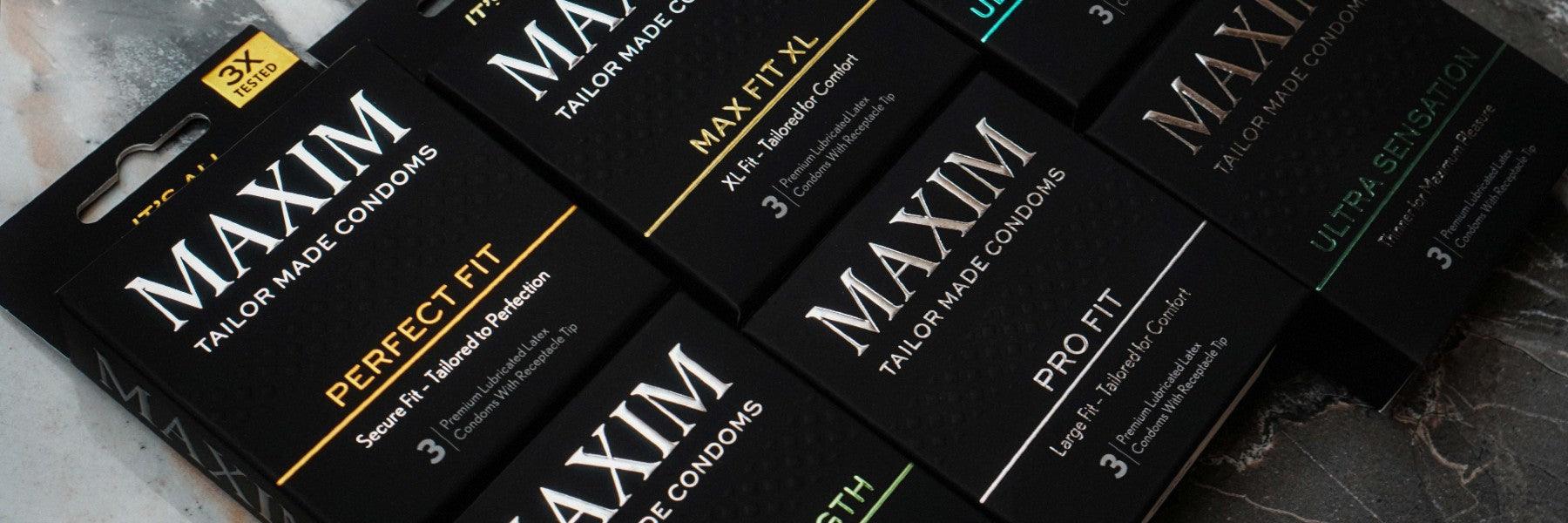Types of Condoms
Condom Sizes and Features
Properly Using an External Condom
The Benefits of Wearing Condoms
When Should I Use a Condom?
Taking Care of Condoms
Can You Use Lube with Condoms?
Do Condoms Expire?
What if the Condom Breaks?
Ultra Fit Condoms Types
Many of us learned about condoms in a pretty unsexy environment: a high school or middle school health class. But if you're interested in preventing unintended pregnancy and/or sexually transmitted diseases (STDs), condoms are a resource you don't want to leave in the drawer. Done right, condoms can be sexy and compelling.
The History of Condoms
While it's impossible to know who first thought up the idea of the condom, historians do know that condoms made from animal intestines were in use at least as far back as the middle ages. Condoms were tied with a ribbon and were usually used to prevent sexually transmitted diseases (STDs) rather than prevent pregnancy.
It's no surprise that "rubber" has become another name for condoms. After the process for vulcanizing rubber was discovered in the mid-1800s, condoms could be made without the need for ribbons to secure them. This is because vulcanized rubber is more elastic and resilient than animal intestines.
Types of Condoms
There are two basic types of condoms, though one is more commonly known than the other.
External Condoms
External condoms are what most people think of when they think of condoms. These cover a penis.
Internal Condoms
Internal condoms can be inserted into a vaginal or anal cavity. Note that a penetrating partner should not wear an external condom while the receiving partner wears an internal condom—this can lead to friction and cause one or both condoms to break.
Internal condoms are used far less often than external condoms, so this article focuses on external condoms. However, many of the rules of thumb regarding external condoms are also relevant to internal condoms.
Condom Sizes and Features

It's essential to know how to buy condoms that fit, not only for your comfort but also for maximum effectiveness. Condoms that are too loose could fall off, and condoms that are too tight risk breaking. Condom packaging generally comes with sizing information to help you figure out how to know your condom size.
There are also different condom styles. A few common varieties include:
- Flavored condoms.
- Bright-colored condoms.
- Ribbed condoms for increased stimulation.
- Polyurethane condoms for people who are allergic to latex.
We happen to have a wide selection of condoms available—but more about that at the end of the article.
Properly Using an External Condom
There's a bit more to using a condom than putting on a sock. After all, there's more at stake.
How To Put on a Condom?
- Remove the condom from the wrapper, and look it over to ensure it isn't damaged.
- Place the condom on the head of an erect penis. Pull back the foreskin if applicable.
- Pinch the tip of the condom to get rid of any excess air.
- Unroll the condom down the complete length of the penis.
- You are now ready for sexual activity! Pro tip: Using a water- or silicone-based lubricant can prevent friction that can damage the condom—and make sex feel better.
How to Take Off a Condom?
- After sex but before pulling out, grab the base of the condom to prevent slippage or spillage. Slowly pull out while holding the condom in place. Try to do this before your penis goes soft to keep the condom from loosening.
- Throw the condom in the trash away from your partner. Do not flush the condom down the toilet, as this can and will clog plumbing.
Keep in mind that a partner can help you put on your condom. This may make the experience more enjoyable and sexy, so give it a try.
The Benefits of Wearing Condoms

Effectiveness at Preventing Pregnancy
Condoms effectively prevent pregnancy 98% of the time when used correctly and consistently. In practice, this dips down to 85% due to user error. Brushing up on proper usage and using them every time you have sex can make condoms a good form of birth control.
Condoms paired with contraception, such as an IUD or birth control pills, can make unintended pregnancy very rare.
Effectiveness at Preventing STDs
Condoms are still the most effective way to prevent most STDs besides abstinence. They make wearers 90% less likely to contract HIV, Hepatitis B, and Gonorrhea.
When Should I Use a Condom?
It's a good idea to use a condom whenever you have sex — especially with someone you haven't been with before — and there is a penis involved. If you or your partner has an STD, it can also prevent the spread of disease. To break it down further:
Vaginal Sex
Using a condom during vaginal sex reduces the risk of unintended pregnancy and STDs.
Anal Sex
Condoms can help prevent STDs during anal sex, just like they do during vaginal sex. Make sure to use plenty of lubricants to avoid friction since the anal cavity does not produce its lubricant.
Oral Sex
For fellatio (blow jobs), an external condom can help prevent STDs.
However, dental dams are the best option for STD prevention during cunnilingus (eating out) or anilingus (rimming). Latex or polyurethane sheets cover the vaginal area or the anus, preventing direct oral contact. You can buy these ready to go or cut a condom to size.
Read: How to prepare for Anal Sex?
What to Use Instead of Condoms
There are several alternatives to condoms for contraception: birth control pills, IUDs, diaphragms, and other comparably effective options. Still, pairing another contraceptive with a condom offers the most protection.
Condoms offer the best protection available against STDs, though. If you're concerned about STDs, condoms are highly recommended.
Taking Care of Condoms
For your condoms to work as intended, you need to take care of them. Do not use a condom if the packaging is damaged or has visible defects upon opening.
Can You Use Lube with Condoms?
Choose a water- or silicone-based lubricant rather than an oil-based lubricant to avoid breaking the condom. A lubricant's packaging will usually indicate safe to use with condoms.

Do Condoms Expire?
Condoms do expire. Think of them sort of like granola bars. They last a long time, but not forever. It's essential that you know how to store condoms properly; always read your condom's packaging and keep it in a cool, dry place. Even though they fit in a wallet, this isn't a great place to store them because the heat and friction can damage them.
What if the Condom Breaks?
If the condom breaks during sex, calmly take it off and put on another. Yes, this may break the mood, but it's worth it to stay protected. This should also be an infrequent experience if your condoms have been properly stored and you've found a brand that fits you.
JIMMYJANE's Best Condoms
Here at JIMMYJANE, we have many condoms for your sexual health needs—and sexual pleasure. Our variety of products can help you know what condoms to buy.
Ultra Fit Condoms Types
Maxim Perfect Fit Condom
If you've found that regular condoms tend to slip, the Max Fit Condom may be for you. It's carefully designed to fit snugly.
Maxim Pro-Fit Condom
The Maxim Pro Fit Condom is designed for people with penises longer and thicker than average.
Maxim Max Fit XL Condom
If the Maxim Pro Fit is too small for you, our Maxim Max Fit XL Condom should do the trick.
Maxim Ultra Sensation Condom
The Maxim Ultra Sensation Condom is our thinnest condom, great for feeling the most sensations during sex.
Maxim Ultra Stimulation Condom
Our Maxim Ultra Stimulation Condom is ribbed and dotted for extra stimulation—for you and your partner.
Maxim Ultra Strength Condom
The Maxim Ultra Strength Condom has the thickest walls out of all our condoms, making it less likely to break.
Conclusion
Condoms are a great resource to have at your bedside table, along with lube. Used correctly, they are very effective at preventing unintended pregnancy and STDs. And make sure to try a few different styles to find the ones that work best for you.
References:
A Short History of the Condom. (June 2017). JSTOR Daily.
Vulcanization. (2014). ScienceDirect.
External (sometimes called Male) Condom Use. (June 2021). Centers for Disease Control and Prevention.
Internal (sometimes called Female) Condom Use. (June 2021) Centers for Disease Control and Prevention.
Condom Size Chart to Help You Find the Right Choice. (June 2021). Verywell Health.
Dental Dam Use. (June 2021). Centers for Disease Control and Prevention.
How effective are condoms?. (Accessed July 2021). Planned Parenthood.
Condoms: Past, present, and future. (July 2015). Indian Journal of Sexually Transmitted Diseases and AIDS.
 Vibrators
Vibrators Toys for Women
Toys for Women Toys for Men
Toys for Men Couples & Partners
Couples & Partners



Share
Catch a Lay, Not Feelings. How To Have A One Night Stand?
How To Talk Dirty: A Complete Guide to Dirty Talk for Beginners